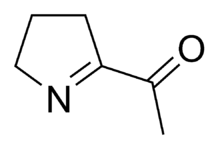2-Acetyl-1-pyrroline
2-Acetyl-1-pyrroline (2AP) is an aroma compound and flavor that gives white bread, jasmine rice and basmati rice, the spice pandan (Pandanus amaryllifolius), and bread flowers (Vallaris glabra) their customary smell.[1] Many observers describe the smell as similar to "hot, buttered popcorn", and it is credited for lending this odor to the scent of binturong (bearcat) urine.[2] Fresh marking fluid (MF) and urine of the tiger (Indian, Amur or Siberian) and Indian leopard also have a strong aroma due to 2AP.[3]
 | |
| Names | |
|---|---|
| Preferred IUPAC name
1-(3,4-Dihydro-2H-pyrrol-5-yl)ethan-1-one | |
| Other names
1-(3,4-Dihydro-2H-pyrrol-5-yl)ethanone 2-Acetyl-1-pyrroline | |
| Identifiers | |
3D model (JSmol) |
|
| ChEBI | |
| ChemSpider | |
| MeSH | 2-Acetyl-1-pyrroline |
PubChem CID |
|
| UNII | |
CompTox Dashboard (EPA) |
|
| |
| |
| Properties | |
| C6H9NO | |
| Molar mass | 111.144 g·mol−1 |
Except where otherwise noted, data are given for materials in their standard state (at 25 °C [77 °F], 100 kPa). | |
| Infobox references | |
2AP and its structural homolog, 6-acetyl-2,3,4,5-tetrahydropyridine of similar smell, can be formed by Maillard reactions during heating of food such as the baking of bread dough. Both compounds have odor thresholds below 0.06 ng/l.[4]
Structure and properties
2AP is a substituted pyrroline and a cyclic imine as well as a ketone.
References
- S. Wongpornchai; T. Sriseadka; S. Choonvisase (2003). "Identification and quantitation of the rice aroma compound, 2-acetyl-1-pyrroline, in bread flowers (Vallaris glabra Ktze)". J. Agric. Food Chem. 51 (2): 457–462. doi:10.1021/jf025856x. PMID 12517110.
- "Why bearcats smell like buttered popcorn". Duke University/Eurekalert. 2016-04-13.
- Brahmachary, Poddar-Sarkar. "Fifty years of tiger pheromone research" (PDF). Archived (PDF) from the original on 2015-06-27. Retrieved 2017-03-25.
- T. J. Harrison; G. R. Dake (2005). "An expeditious, high-yielding construction of the food aroma compounds 6-acetyl-1,2,3,4-tetrahydropyridine and 2-acetyl-1-pyrroline". J. Org. Chem. 70 (26): 10872–10874. doi:10.1021/jo051940a. PMID 16356012.